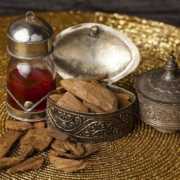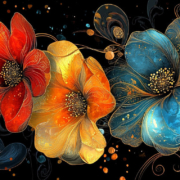Jasmine Perfume – Properties, Distillation, and History

Night-blooming jasmine flowers on an old wooden natural background.
Table of contents
-
Botanical identity and overview
-
Properties
-
Distillation
-
History
-
Sources of jasmine flowers
-
How does jasmine perfume smell like?
-
Warning
-
Final words
Botanical identity and overview
Jasmine, botanically known as Jasminum officinalis, is a flowering herb of the olive family. Jasmine absolute is highly valued in perfumery to produce jasmine perfumes for its distinctive floral scents.
In aromatherapy and in natural holistic medicine jasmine is believed one of the most promising agents to relieve tension, anxiety, nervous fatigue, stress, and a variety of depressive and emotional conditions. It’s also well known for its anti-inflammatory, antiseptic, and antiviral actions.
Properties
Jasmine perfume oil has diverse uses and benefits, making it one of the most expensive natural oils in the world. About 1 million flowers are required to produce 1 kg of jasmine absolute.
In the first line, jasmine is all about perfumes. Jasmine, popularly known as “the Queen of the night“, emanates its distinctive romantic aroma during the night. It helps to maintain emotional balance by promoting euphoric and peaceful feelings.
Jasmine improves skin appearance by balancing the moistures and tones. It has been used in skin and beauty regimens for centuries in China, Egypt, and India. It shows significant effects on several skin conditions such as aging, dryness, dermatitis, eczema, and scars.
Jasmine helps to alleviate stress and anxiety without producing any sedative effects. Therefore, it’s also useful in reducing inflammatory conditions caused by emotional stress.
Jasmine helps to improve sleep quality. Its expectorant, antispasmodic, and relaxing actions promote sleep cycle as well as restfulness.
Jasmine has tremendous antispasmodic properties. It can counter several spasmodic conditions of the body including intestinal spasms, muscle cramps, bronchospasms, and spasmodic coughs.
Jasmine is an effective natural disinfectant and antiseptic. The chemical compounds present in jasmine oil have antibacterial, antiviral, antifungal, and germicidal properties.
Jasmine has a long history of medicinal use as an aphrodisiac. It enhances libido, releases inhibitions, and inspires sexual desire.
Jasmine is a natural substance to improves menstrual health in women. It helps to regulate the menstrual cycle, reduce uterine pain, delay the onset of menopause, and improve mood swings.
Distillation
Unlike other essential oils, steam distillation isn’t used to derive jasmine oil. The process has two special sections that are used to extract the oil from the flower.
At first, jasmine concrete, a waxy fragrant substance, is extracted from the jasmine flowers by using hexane. This concrete can be sold as it is or processed further to produce the essential oil.
Jasmine concrete is prepared as quickly as possible after picking up the flowers so that the flowers remain fresh and don’t lose their fragrance during the process. Therefore, jasmine concrete is typically prepared in the garden where the flowers are grown.
Now, in the second section of the process jasmine absolute is prepared. The concrete is washed several times with the ethanol solution. Then, the liquid is distilled to produce the absolute form.
Jasmine concrete can wait for long periods without losing the fragrance quality before transforming it into an absolute. Sometimes, jasmine concrete is prepared at one place and then it is exported to another country where the absolute is derived through a refined method.
History
The origin of Jasmine is believed to have been in ancient Persia, now known as Iran. It has been found in Egypt since the early 1000 BCE. In Ancient Egypt, jasmine flowers were poured into bathing water in luxurious hot baths. Jasmine flowers were used to decorate tombs, mummies, and statues.
In India, Jasmine flowers have been continuously cultivated since at least 300 BCE. Mostly in the southern town of Madurai for both purposes local use and export. Jasmine flowers are used in religious programs and weddings, as a decorative agent as well as a flavoring for teas and sweets.
Jasmine came to China most probably from South Asia during the period of the Han Dynasty, which ruled China from 206 BCE to 220 CE. In the 7th century CE, during the period of the Tang Dynasties, the upper-class people frequently used to wear perfumes including Jasmine perfumes. In the Song Dynasty (960 to 1279), Jasmine teas were documented and may have been discovered earlier. At that time, Jasmine teas were reserved only for royal people.
The Arab trade network first introduced jasmine to Europe at some point between the 1550s and 1600s. The budding perfume industry of Europe rapidly embraced jasmine. Since then, the finest jasmine has been continuously growing in France, in the Grasse area. According to reliable data, about 27 tons of jasmine flowers are harvested every year in Grasse, making it one of the largest jasmine producers in the world.
The species Jasminum Sambac was first introduced to the Philippines around the 1700s. Jasmine was traditionally used in perfumes, flower wreaths, and Sampaguita. In 1935, jasmine was adopted as the national flower of the Philippines.
In 1990, the jasmine flower was also recognized as the national flower of Indonesia in recognition of its huge popularity.
Jasmine is the national flower of Tunisia as well. Andalusians first introduced the flower to the country around the 1600s. Jasmine became very popular rapidly, so much so that the presidency change in 1987 and the Tunisian Revolution of 2011 both were referred to as “Jasmine revolutions” by major media houses.
Sources of Jasmine flowers
The two major types of jasmine species are widely used to produce jasmine perfumes and attars – Jasminum grandiflorum and Jasminum sambac. Jasminum sambac is widely grown in Southeast Asia for perfumery and other purposes.
In the present day, Egypt is assumed to have the largest market of jasmine essential oil in the world. Along with Egypt India, France, and Morocco produce great quality jasmine oil and supply most portion of the global demand.
How does jasmine perfume smell like?
Jasmin perfume or jasmine attar emanates a very distinctive intense floral, sweet, smooth, and musky scents that can linger for a long period. The strong scents of jasmine can stimulate the brain and nervous system to promote feelings of happiness and well-being.
Warning
As jasmine has effects on hormones and the uterus, pregnant women must consult their doctors before using it.
Final words
Jasmine perfume is a perfect choice for a modern-day busy schedule to enhance inner serenity and peace of mind. It can be used alone or can be blended with other essential oils as well.
It’s highly recommended to use only natural jasmine perfumes to enjoy the healing effects of this flower rather than using synthetic products that are often associated with adverse effects.
At La Via del Profumo, we produce only natural and best jasmine perfumes and attars using only pure and natural substances.
Here you can check out our jasmine perfumes and attars.
























Leave a Reply
Want to join the discussion?Feel free to contribute!